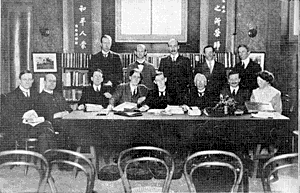|
OBJECTING TO WAR
FIRST CO TO DIE
2 EUROPE GOES TO WAR
3 COUNTDOWN TO CONSCRIPTION
4 FUNDAMENTAL CHANGE IN SOCIETY
5 NO CONSCRIPTION FELLOWSHIP
6 THE SECRET PRESS
7 MANY TRADITIONS
8 THE TRIBUNALS
9 TRANSCRIPS
10 THE 'won't-fight-funks'
11 THE COST OF CONSCIENCE
12 UNWILLING SOLDIERS
13 ALTERNATIVES AND DILEMMAS
14 PRISON
15 THE MEN SENTENCED TO DEATH
16 COERCION FAILS
17 DYCE
18 DARTMOOR
19 THEY WORK IN OVERCOATS
20 THE MEN WHO DIED
21 WINDING DOWN
21 SELECTION OF BOOKS
22 FROM CALL UP TO DISCHARGE
WHY WAR? supplement
|
|
|
11 THE COST OF CONSCIENCE
One question that troubled the leaders of the No Conscription Fellowship was this: how far could – and should – men carry their protest against conscription? How did one draw a line between action that put strong enough pressure on the government, and action that could break the spirit (and health) of the men involved? For some NCF members, refusal to fight was part of a larger process, one that would lead to the eventual overthrow of the military machine and the ending of the war. But most wondered if it was right to force men into doing things beyond their capacity to endure. Could everyone be expected show the same courage in the face of ill-treatment or extreme conditions?
|
 |
|
Conscientious objectors were usually offered non-combatant work in the army, or civilian work (for example, working on the land) that was useful to a country at war. Men who turned down these alternatives, and men who had not even been offered them but still refused call-up, were then arrested and sent to military barracks. Here they faced court martial, like any soldier who disobeyed orders – as indeed the COs did, refusing to wear uniform or respond to any commands. The court martial would give a prison sentence, to be served in a civilian prison. When the CO had finished his time in prison, he would be called up again a day after his release and arrested when he failed to obey: this was known as the ‘cat and mouse’ process. It was all very tough on the men who endured it. More than seventy COs died in prison or as a result of their experience there. Some became physically or mentally ill, and of these some never fully recovered.
|
|
|
|
No Conscription Fellowship National Committee meeting May 1916
Front row left to right: C.H. Norman, Dr Alfred Salter, Aylmer Rose, Fenner Brockway, Clifford Allen, Edward Grubb, Will Chamberlain, Catherine Marshall. Standing left to right: Rev. Leyton Richards, Morgan Jones, John P. Fletcher, A Barratt Brown, and Bertrand Russell.

|
|
They had to face more than physical hardship. Lloyd George, when Secretary of State for War, summed up the intense hostility that many in Parliament now felt for these' absolutists'. With 'that kind of man,' he declared, 'I, personally, have absolutely no sympathy whatsoever... I shall only consider the best means of making the path of that class as hard as possible.'
COs faced these unpleasant consequences with responses as varied as themselves. Their only backing came from peace groups and a small group of Members of Parliament, and above all from the sustained vigilance of the No-Conscription Fellowship. Despite continual harassment by the police (which meant going partly 'underground') the NCF managed to keep track of almost all COs, provide moral and physical support for some of their families, and campaign against the harsh treatment and imprisonment so many of them endured. The NCF was fortunate in its leaders - intelligent and dedicated men - and in its organiser, a formidably efficient ex-suffragette: Catherine Marshall reckoned that for aiding COs she was technically liable to 2,000 years in prison!
|
